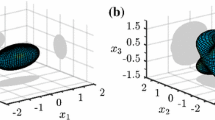Abstract
In this paper a new method for obtaining functions with a given singular behavior that satisfy a class of partial differential equations is presented. Differential equations of this class contain operators of the form \({\nabla^{2n}}\), where n is a positive integer. The method uses Wirtinger calculus which enables one to invert the Laplacian in combination with the decomposition method introduced by Adomian at the end of the twentieth century. The procedure uses a singular holomorphic function as its basis, and constructs the solution term by term as an infinite series of functions; the process consists of an infinite number of steps of integration. This method is applied to construct a number of singular solutions to the modified Helmholtz equation in the context of groundwater flow. These functions are discharge potentials, which are two-dimensional functions by definition. The gradient of the discharge potential is the vertically integrated flow over the thickness of an aquifer, or water-bearing layer. The discharge potentials of interest here are those used in the analytic element method. This method, as originally conceived, relies on the superposition of suitably chosen holomorphic functions, and is a form of a method known as the Trefftz method, not to be confused with the Trefftz method applied to finite element techniques. The main analytic elements used are singular line elements, characterized by either a jump along the element in the tangential or the normal component of the discharge vector. The analytic line elements for the case of divergence-free irrotational flow are well established and many of these are forms of singular Cauchy integrals. Application of the analytic element method to more general cases of flow, governed for example by the modified Helmholtz equation (flow in systems of aquifers separated by leaky layers) and the heat equation (transient flow) is possible using the method presented in this paper. The latter application is beyond the scope of this paper, but it is worth noting that for that case the constant that occurs in the modified Helmholtz is replaced by a general function of time and application of Laplace transforms can be avoided. A method for constructing such functions is presented; the procedure for constructing these functions is referred to as the generating analytic element approach. Application of this approach requires the existence of the holomorphic singular line element. The approach is discussed and an example for the case of a line-sink for a system of two aquifers separated by a leaky layer and bounded above by in impermeable boundary is presented.
Similar content being viewed by others
References
Wirtinger W: Zur formalen Theorie der Funktionen von mehrenen komplexen Veranderlichen. Mathematischen Annalen 97, 357–375 (1927)
Remmert R: Theory of complex functions. Springer-Verlag, New York (1991)
Adomian G: Solving Frontier problems of physics: the decomposition method. Kluwer Academic Publishers, Dordrecht (1994)
Strack ODL: Groundwater mechanics. Prentice-Hall, Inc, Englewood Cliffs, New Jersey (1989)
Haitjema HM: Analytic element modeling of groundwater flow. Academic Press, Inc, San Diego, USA (1995)
Strack ODL: Theory and applications of the analytic element method. Rev Geophys 41(2), 1–16 (2003)
Bakker M, Strack ODL: Analytic elements for multi-aquifer flow. J Hydrol 271, 119–129 (2003)
Polubarinova-Kochina PY: Theory of groundwater movement. Princeton University Press, Princeton, New Jersey (1962)
Hemker CJ: Steady groundwater flow in leaky multiple-aquifer systems. J Hydrol 72, 1911–1919 (1984)
Maas C: The use of matrix differential calculus in problems of multiple–aquifer flow. J Hydrol 99, 43–67 (1986)
Maas C: Groundwater flow to a well in a layered porous medium. Water Resour Res 23(8), 1675–1681 (1987)
Heitzman G (1977) Analytical modeling of multi-layered groundwater flow. Master’s thesis, University of Minnesota, Minneapolis, Minnesota
Keil GD (1982) A Dupuit analysis for leaky unconfined aquifers. Master’s thesis, University of Minnesota, Minnepolis, Minnesota
Hanson DD (2002) Analytic modeling of leakage in a confined multiple aquifer system. Master’s thesis, University of Minnesota, Minneapolis, Minnesota
Moon PH, Spencer D: Field theory handbook including coordinate systems differential equations and their solutions. Springer-Verlag, New York (1961)
Strack ODL (2009) Using Wirtinger calculus and holomorphic matching to obtain the discharge potential for an elliptical pond. Water Resour Res 45(W01409):doi:10.1029/2008WR007128
Abramowitz M, Stegun IA: Handbook of mathematical functions. Dover Publications, Inc, New York (1965)
Janković I (1997) High-order analytic elements in modeling groundwater flow. PhD thesis, University of Minnesota, Minneapolis, Minnesota
Janković I, Barnes R: High-order line elements in modeling two-dimensional groundwater flow. J Hydrol 226, 211–223 (1999)
Strack ODL: Flow in aquifers with clay lamina, 1. the comprehensive potential. Water Resour Res 17(4), 985–992 (1981)
Strack ODL, Janković I, Barnes R: The superblock approach for the analytic element method. J Hydrol 226(3-4), 179–187 (1999)
Author information
Authors and Affiliations
Corresponding author
Rights and permissions
About this article
Cite this article
Strack, O.D.L. The generating analytic element approach with application to the modified Helmholtz equation. J Eng Math 64, 163–191 (2009). https://doi.org/10.1007/s10665-009-9279-x
Received:
Accepted:
Published:
Issue Date:
DOI: https://doi.org/10.1007/s10665-009-9279-x



